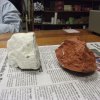
|
On: 2012-11-15 15:48:42
awarenet Open Day visitor changed content of section 850565312162211330 to
|
|
|
Commercially, in terms of mining, Kaolin is used in ceramics, medicine, food additives,toothpaste and cosmetics to name a few.
Have a look at this web site to find out more:
Uses of Kaolin.These are the general uses for Kaolin, however in South Africa, including Grahamstown, it also has traditional cultural uses. It is also used as sunblock.

|
On: 2012-03-19 11:57:50
Lelethu Bodlani changed content of section 134954609390061268 to
|
|
|
On the afternoon of the 28th February 2012 I Lelethu Bodlani had an interview with Mr. Anonymous. He is a very cultural man with lots of knowledge about kaloin and find it very important to learn about kaloin or ifutha when it appears white and imbola if it appears red.
Interview Questions
1. What does Kaolin mean in your culture and what significance does it have?
2. I.m sure you've used kaolin before. How was you expierence with it.
2.1. How did it smell?
2.2. How long was it used for?
2.3. Is it applied on the entire body or just the face?
3. Is it neccessary during cirumsition to use it?
(As does it make you less of a man of you don't?)
4. Why is that it's mainly used during circumsition , can't people use it any other way. Susch as sunblock per say?
5. Would it undermine the culture if a woman where to use it?
6) Are there any other interesting facts that you would like to share with us today?
The answers from the interview:
1) Kaolin has a big impact on circumsition. There are mainly two types of circumsition in varies cultures. The first is the circumsition of umkwetha which is the ritual of boys changing into men. These boys have to apply kaolin or ifutha on their entire body. Scientifically white is worn or is seen as the colour that doesn't radiate heat that is why 'ifutha' is used, as it keeps the body cool. When their about to leave, they wash ifutha off as they feel as if their washing away the bad luck and dirtyness of "boyhood' and getting into manhood with good blessings.
2.1) It didn't really have a smell.
2.2) It depends really on how long your stay is, which mainly depends on how fast or slow you healed in the process.
2.3) it is applied on the entire body.

|
On: 2012-03-18 07:32:49
Lelethu Bodlani changed content of section 134954609390061268 to
|
|
|
On the afternoon of the 28th February 2012 I Lelethu Bodlani had an interview with Mr. Anonymous. He is a very cultural man with lots of knowledge about kaloin and find it very important to learn about kaloin or ifutha when it appears white and imbola if it appears red.
Interview Questions
1. What does Kaolin mean in your culture and what significance does it have?
2. I.m sure you've used kaolin before. How was you expierence with it.
2.1. How did it smell?
2.2. How long was it used for?
2.3. Is it applied on the entire body or just the face?
3. Is it neccessary during cirumsition to use it?
(As does it make you less of a man of you don't?)
4. Why is that it's mainly used during circumsition , can't people use it any other way. Susch as sunblock per say?
5. Would it undermine the culture if a woman where to use it?
6) Are there any other interesting facts that you would like to share with us today?
The answers from the interview:
1) Kaolin has a big impact on circumsition. There are mainly two types of circumsition in varies cultures. The first is the circumsition of umkwetha which is the ritual of boys changing into men. These boys have to apply kaolin or ifutha on their entire body. Scientifically white is worn or is seen as the colour that doesn't radiate heat that is why 'ifutha' is used, as it keeps the body cool. When their about to leave, they wash ifutha off as they feel as if their washing away the bad luck and dirtyness of "boyhood' and getting into manhood with good blessings luck.
There is still more information to be confirmed.

|
On: 2012-03-11 12:57:37
Sarah Hanton changed content of section 850565312162211330 to
|
|
|
Commercially, in terms of mining, Kaolin is used in ceramics, medicine, food additives,toothpaste and cosmetics to name a few.
Have a look at this web site to find out more:
Uses of Kaolin.These are the general uses for Kaolin, however in South Africa, including Grahamstown, it also has traditional cultural uses. It is also used as sunblock.

|
On: 2012-03-11 12:42:24
Sarah Hanton changed content of section 190988245794121679 to
|
|
|
On Monday the 5th of March,Mrs Hanton and I went to Makana Brick to get more information on Kaolin.I interviewed Colin Meyer(CEO) along with Mark Van Zyl who is the Sales Manager of the company.Here is some information obtained from the interview.
The company was started by Colin Meyer in 1994.Before that the factory used to be farm and the factory is built on clay.The geographic sales area are from Mossel bay and extend to Kokstad.They obtain their clay from a nearby quarry.Kaolin is the main source and this can be made into shale as well.Makana Brick has two factories.The old factory is plant one and it produces bricks solid bricks.The second factory is plant two and it produces bricks with holes but these come in various patterns.
Interesting Fact-There is a theory that in the construction of the Union Buildings in Pretoria some bricks could have come from Grahamstown since various building materials were taken from different parts of South Africa!
There is more information from this interview that will be revealed later on!
By:Inga Macingwane

|
On: 2012-03-07 14:51:13
Blessings Chinganga changed content of section 356860939121938309 to
|
|
|
Kaolin is a clay mineral that is white, soft and earthy created by the chemical weathering of aluminium silicate minerals such as Feldspar. In many regions of the world where iron-oxide is high in concentration, it's coloured pink-orange-red but where the concentration is lighter, it's usually white, yellow or light orange in colour. Kaolin is used in a lot of industries, some of them being the paper industry, the concrete industry, the plastics industry and even in agriculture! This clay is used because of its ability to stay inert over a wide ph range and that makes it very attractive for most industries to use.



|
On: 2012-03-06 18:55:32
Sarah Hanton created new section
|
|
|
562776313188258331

|
On: 2012-03-06 18:55:32
Sarah Hanton changed title of section 562776313188258331 to
|
|
|
Gallery of pictures

|
On: 2012-03-06 18:54:00
Sarah Hanton changed content of section 190988245794121679 to
|
|
|
On Monday the 5th of March,Mrs Hanton and I went to Makana Brick to get more information on Kaolin.I interviewed Colin Meyer(CEO) along with Mark Van Zyl who is the Sales Manager of the company.Here is some information obtained from the interview.
The company was started by Colin Meyer in 1994.Before that the factory used to be farm and the factory is built on clay.The geographic sales area are from Mossel bay and extend to Kokstad.They obtain their clay from a nearby quarry.Kaolin is the main source and this can be made into shale as well.Makana Brick has two factories.The old factory is plant one and it produces bricks solid bricks.The second factory is plant two and it produces bricks with holes but these come in various patterns.
Interesting Fact-There is a theory that in the construction of the Union Buildings in Pretoria some bricks could have come from Grahamstown since various building materials were taken from different parts of South Africa!
There is more information from this interview that will be revealed later on!
By:Inga Macingwane

